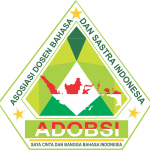ANALISIS WACANA KRITIS PADA STAND UP COMEDY INDONESIA
Abstract
This study aims to demystify the stereotypes of Eastern Indonesian citizens. Specifically, the problem of this study is formulated as: (1) What rhetorical strategy and text structure are used in developing themes?, (2) What social cognition can be identified through audience response to the stereotypes of Eastern Indonesian citizens? (3) What social context can be built in response to the stereotype of Eastern Indonesian citizens? The object of study in the form of transactional oral text delivered by the comic Abdur Arsyad at Show 8, SUCI season 4, with the theme of Women, was taken randomly and analyzed with the critical discourse study approach by Teun A. Van Dijk, free-of-charge skills, and methods extra lingual equivalent. The findings of this study indicate that Abdur uses epideictic rhetoric in the form of a single unit in a text structure (joke map), consisting of 13 sub-goals, each containing 3 phases, namely: premise, set-up, and punchline. Meanwhile, cognition in the form of 10 allusions and stereotypes of the rigors of Eastern Indonesian citizens proved to be within the scope of audience knowledge through applause. Furthermore, the social context - a stereotype of Eastern Indonesian citizens was built to explain the cultural background and comic efforts to reduce the stereotype. Thus this study has a significant contribution to the addition of linguistic treasures related to Stand Up Comedy linguistic activities.
Keywords
Full Text:
PDFReferences
Ali, A. R. M. (2019). Stand Up Comedy Indonesia sebagai medium satire terhadap isu diskriminasi sosial (studi semiotik Stand Up Comedy Indonesia Periode 2011–2018 di Kompas TV). Tesis. Surabaya: Universitas Airlangga. Retrieved from http://repository.unair.ac.id/id/eprint/87314
Bahrurozak, M. (2019). Telaah gaya sindiran dalam tuturan Stand Up Comedy pada akun Youtube DPR RI. Thesis. Malang: University of Muhammadiyah Malang. Retrieved from http://eprints.umm.ac.id/id/eprint/58725
Bihari, I., & Yeldho, J. V. (2020). The humor in being black: di Hughley, Kevin Hart And Stand-Up Comedy. SocArXiv. https://doi.org/10.31235/osf.io/7bnpg
Diana, S., Tallapessy, A., & Bela, A. H. N. (2019). Representing victim of violence in news: female victim of UGM’s case in the Jakarta Post’s articles. Haluan Sastra Budaya, 3(2), 203–219. https://doi.org/10.20961/hsb.v3i2.32778
Fathoni. (2017). Bangsa ini hilang selera humor, makanya sering berselisih. Retrieved May 12, 2020, from https://www.nu.or.id/post/read/82405/bangsa-ini-hilang-selera-humor-makanya-sering-berselisih
Filani, I. (2020). A discourse analysis of national identity in Nigerian stand-up humour. Discourse Studies, 1461445620906035. https://doi.org/10.1177/1461445620906035
Firdaus, A. Y., Setiawati, S., & Yulianto, E. (2018). Satire on Stand Up Comedy “Messake Bangsaku” By Pandji Pragiwaksono. Hortatori: Jurnal Pendidikan Bahasa Dan Sastra Indonesia, 2(2), 80–86. https://doi.org/10.30998/jh.v2i2.67
Firmansyah, R. S. (2019). Revealing racial hegemony in Nike advertisement campaigns on Youtube: a systematic multimodal critical discourse analysis. Haluan Sastra Budaya, 3(2), 189–202. https://doi.org/10.20961/hsb.v3i2.32818
Ibrahim, G. M. (2019, August 25). Stand Up Comedy kritik DPR mulai digelar. DetikNews, p. 1. Retrieved from https://news.detik.com/berita/d-4679989/stand-up-comedy-kritik-dpr-kembali-digelar
Istiyova, L. R. (2018). Manfaat aplikasi instagram sebagai pendidikan berbahasa Indonesia generasi masa kini. https://doi.org/10.31227/osf.io/hvjrf
Muhammad, S. (2019). Pemaknaan materi satire dalam Stand Up Comedy Pandji Pragiwaksono di Youtube”(Studi resepsi pada Stand Up Comedy Banjarbaru). University Of Muhammadiyah Malang, Malang. Retrieved from http://eprints.umm.ac.id/id/eprint/50809
Novianti, H. (2017). Main Article Content. Nusantara of research: jurnal hasil-hasil penelitian Universitas Nusantara PGRI Kediri, 4(1), 39–44. Retrieved from https://ojs.unpkediri.ac.id/index.php/efektor/article/view/643
Novita, I. (2019). Analisis sarana retorika dalam Stand Up Comedy Raditya Dika. Bahastra: Jurnal Pendidikan Bahasa Dan Sastra Indonesia, 3(2), 126–132. Retrieved from https://jurnal.uisu.ac.id/index.php/Bahastra/article/view/1151
Rodgers, L. (2020). Not a joke: women’s work and feminist laughter in stand-up comedy. Canada: Queens University. Retrieved from http://hdl.handle.net/1974/27557
Romansyah, T. S., Hidaya, D. N., & Setiono, D. P. (2020). A critical discourse analysis of Dzawin’s Stand Up Comedy Humor, 5(1). https://doi.org/http://dx.doi.org/10.4108/eai.30-9-2019.2291197
Setiawan, E. (2012). Kamus Besar Bahasa Indonesia Online. Jakarta: Pusat Bahasa. Retrieved from https://kbbi.web.id/alusi, https://kbbi.web.id/stereotype, https://kbbi.web.id/stigma
Sumarlam, S. (2016). Representasi Kekuasaan melalui sabda raja pada teks berita mengenai konflik internal Keraton Yogyakarta (sebuah analisis wacana kritis). Prosiding Prasasti, 3(1), 58–70. https://doi.org/https://doi.org/10.20961/pras.v0i0.1444.g1338
Sutriyanto, E. (2013, May 12). Kompas TV gelar audisi Stand Up Comedy Indonesia 4 Artikel ini telah tayang di Tribunnews.com dengan judul Kompas TV Gelar Audisi Stand Up Comedy Indonesia 4, https://www.tribunnews.com/seleb/2013/12/21/kompas-tv-gelar-audisi-stand-up-comedy-indonesia-4 E. Tribunnews.Com, p. 1. Retrieved from https://www.tribunnews.com/seleb/2013/12/21/kompas-tv-gelar-audisi-stand-up-comedy-indonesia-4
Refbacks
- There are currently no refbacks.






